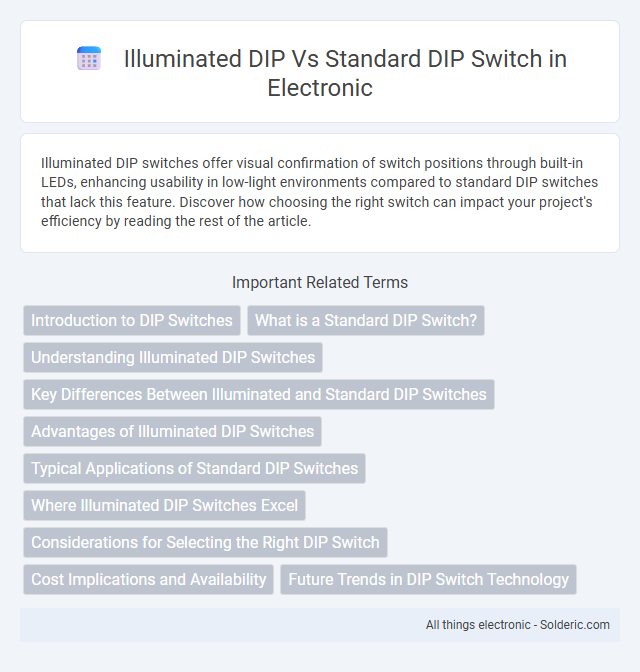Illuminated DIP switches offer visual confirmation of switch positions through built-in LEDs, enhancing usability in low-light environments compared to standard DIP switches that lack this feature. Discover how choosing the right switch can impact your project's efficiency by reading the rest of the article.
Comparison Table
| Feature | Illuminated DIP Switch | Standard DIP Switch |
|---|---|---|
| Indicator Light | Built-in LED to show switch status | No indicator light |
| Visual Feedback | Immediate visual confirmation | No visual confirmation |
| Application | Used where switch status visibility is critical | Used for basic on/off configuration |
| Power Consumption | Consumes extra power for LED | No additional power required |
| Cost | Higher cost due to LED integration | Lower cost |
| Complexity | More complex design | Simple mechanical design |
Introduction to DIP Switches
DIP switches serve as small manual electronic switches used to configure devices and set hardware options. Illuminated DIP switches differ from standard types by integrating LED indicators that provide visual feedback on switch status, enhancing usability in low-light environments. This illumination feature aids troubleshooting and ensures accurate configuration by clearly displaying which switches are active.
What is a Standard DIP Switch?
A standard DIP switch is a manually operated electrical component consisting of a set of small switches packaged in a dual in-line configuration, allowing users to toggle individual switches ON or OFF to configure circuits. It provides simple binary input options commonly used for device settings, address configurations, or feature selection without requiring software control. These switches lack built-in illumination, relying solely on physical position indicators to convey their status.
Understanding Illuminated DIP Switches
Illuminated DIP switches integrate LEDs with traditional DIP switch configurations, providing visual status indicators for each switch position. These LEDs enhance usability by allowing you to quickly identify active settings without needing additional testing equipment. Compared to standard DIP switches, illuminated variants offer improved troubleshooting capabilities and streamlined system diagnostics in complex electronic applications.
Key Differences Between Illuminated and Standard DIP Switches
Illuminated DIP switches incorporate built-in LEDs that provide visual feedback when toggled, enhancing usability in low-light environments compared to standard DIP switches, which lack this feature. The LED indicators in illuminated DIP switches allow for immediate status recognition, improving troubleshooting efficiency in complex electronic systems. Unlike standard DIP switches, illuminated versions consume additional power due to the integrated LEDs, which should be considered in power-sensitive applications.
Advantages of Illuminated DIP Switches
Illuminated DIP switches provide clear visual feedback, making it easier to identify switch positions in low-light or complex environments, reducing setup errors. Their built-in LED indicators enhance troubleshooting efficiency and operational reliability, especially in industrial and electronic applications. You benefit from faster diagnostics and improved system monitoring, which standard DIP switches without illumination cannot offer.
Typical Applications of Standard DIP Switches
Standard DIP switches are commonly used in electronic devices for setting configurations such as device addressing, mode selection, and feature enabling. They are frequently found in telecommunications equipment, industrial machinery, and consumer electronics where simple, reliable manual input is necessary. Their non-illuminated design suits environments where visibility of switch status is not critical.
Where Illuminated DIP Switches Excel
Illuminated DIP switches excel in environments requiring visual status indication, improving troubleshooting and device status monitoring. Their built-in LEDs provide immediate feedback, reducing downtime and errors in complex electronic systems. Your projects benefit from enhanced visibility and reliability when using illuminated DIP switches over standard models.
Considerations for Selecting the Right DIP Switch
Selecting the right DIP switch involves evaluating factors such as visibility, power consumption, and operating environment. Illuminated DIP switches provide enhanced visual feedback through integrated LEDs, ideal for low-light conditions or status indication, but may consume more power than standard DIP switches. Your choice should balance the need for clear status indication against energy efficiency and circuit complexity.
Cost Implications and Availability
Illuminated DIP switches typically cost more than standard DIP switches due to the added components, such as LEDs and necessary circuitry, which also influence manufacturing complexity. Availability of illuminated DIP switches can be limited compared to standard DIP switches, as they are less commonly produced and stocked by suppliers. Your choice between the two should consider budget constraints and the ease of sourcing the required switch type for your project.
Future Trends in DIP Switch Technology
Illuminated DIP switches are evolving to offer enhanced visibility and user feedback, integrating LEDs for easier identification in low-light environments compared to standard DIP switches. Future trends emphasize miniaturization, increased customization options, and smart integration, allowing you to remotely monitor and control DIP switch settings via IoT connectivity. Advances in materials and energy efficiency will also drive the shift toward greener, more durable illuminated DIP switch solutions.
illuminated DIP vs standard DIP switch Infographic

 solderic.com
solderic.com